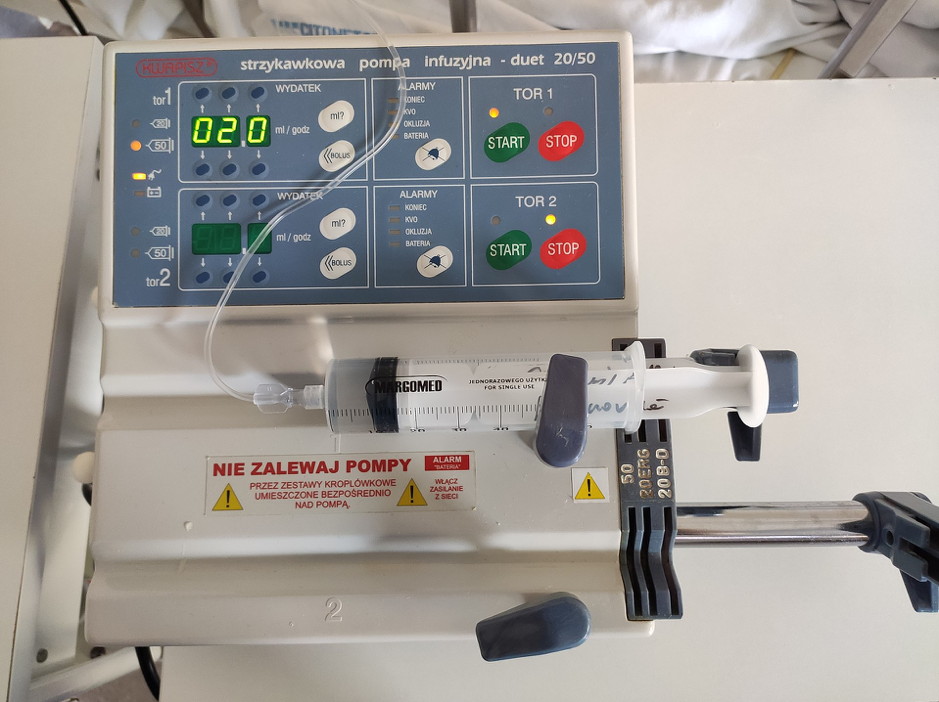Infusion pumps: overview

The CHI+MED team have extensively studied infusion pump design as one of several classes of device our research has targeted. Our analysis tools and techniques have demonstrated previously undetected defects in the user interface of commercial medical devices in use in hospitals across the US and EU. Several identified defects have safety implications, as they could cause use errors such as misconfiguration of infusion parameters that could lead to patient harm.
CHI+MED is a UK-based research project on improving the usability and safety of interactive (human-computer) medical systems. We have established successful research collaborations with leading international research centers, including the Center for Devices and Radiological Health of the US Food and Drug Administration (FDA/CDRH), and the Precise Research Center of the University of Pennsylvania. We are working with them on a new safety standard for medical user interfaces.
We are also working on the development of industrial strength, internationally used analysis tools with international research teams including from SRI, USA; NASA Langley Research Center, USA; the Aarhus University, Denmark; the University of Geneva, Switzerland; the University of Pisa, Italy; the University of Waikato, New Zealand; and the University of Minho, Portugal.
More specific information about our research in this area, including with the US regulator, the Food and Drug Administration (FDA) on infusion pumps is available for the research areas below.
Infusion use
We have built a picture of how UK hospitals are using and managing, in various contexts, the infusion devices (pumps) that deliver medication to patients. Smart pumps, which can alert nurses when unusual infusion values are set, are only occasionally used in UK hospitals, despite their potential benefits for safety. Barriers to using smart pumps include existing contracts; decision-makers may need to be convinced that the benefit is worth the effort needed to adopt them. The Singleton Hospital is using our research as a driver to introduce smart pump software.
Model-based design and engineering
We have created tools that support the model-based design of user interfaces. We have then shown that using them can lead to design problems being found early in the design process when they are cheap to fix.
Verification of user interface software
We have developed techniques for checking mathematically that the user interfaces of infusion pumps are safe and easy to use. We have used our methods to find safety problems in existing commercial infusion pumps. The results are being used by regulators and hospitals to raise awareness about the problems found.
The Generic Infusion Pump user interface architecture
We have developed a reference architectural model for modern infusion pumps (the GIP-UI); used it to carry out a preliminary hazard analysis for commercial infusion pump software, and identified user interface design issues to explain common problems reported in infusion pump incidents.
A hazard analysis for infusion pump user interface software
We have: identified a substantial set of use-related hazards for infusion pumps data entry systems, and explored systematic analysis techniques for identifying use-related hazards.
HCI and human factors
We have identified previously unnoticed human factors related design issues in the data entry system of commercial infusion pumps; investigated how infusion pumps are actually used in real work environments; and developed specialised tools that can be used within a regulatory framework to analyse the user interface of existing devices and support the design of a new generation of safer and more usable medical devices.
Data loggers and forensic analysis
We have carried out studies of logs from hospital infusion pumps that have highlighted problems with the pumps?? designs. The results have been used to alert hospitals to the issues so they can raise awareness of the problems amongst clinicians who use the pumps. The studies have also suggested improvements to the way the data loggers work that would better support the investigation of safety incidents by providing stronger evidence of what happened.
Diverse use: infusion device use in practice – one size does not fit all
We have identified important differences between the assumptions made during design about how infusion devices will be used and the ways that they are actually used in practice. We have also identified important differences in the ways that infusion devices are used in different contexts, and for different purposes. We have developed and shared a set of resources that illustrate the variations in the ways that devices are used.
Refinement in developing and verifying user interface requirements for infusion pumps
Criteria for the acceptable safety of medical devices, safety requirements, are typically described precisely, but in natural languages like English. An important issue is reassuring regulators that the given requirements are satisfied. We have developed a refinement based approach that involves gradually transforming a requirement into a form that can be coded. It relates to the pre-market review process promoted by the FDA to provide safety assurances. Our approach helps to both design and clarify high-level safety requirements that relate to user interfaces of medical devices. It also supports the development of usage models for a range of interaction methods and their verification against safety requirements.
